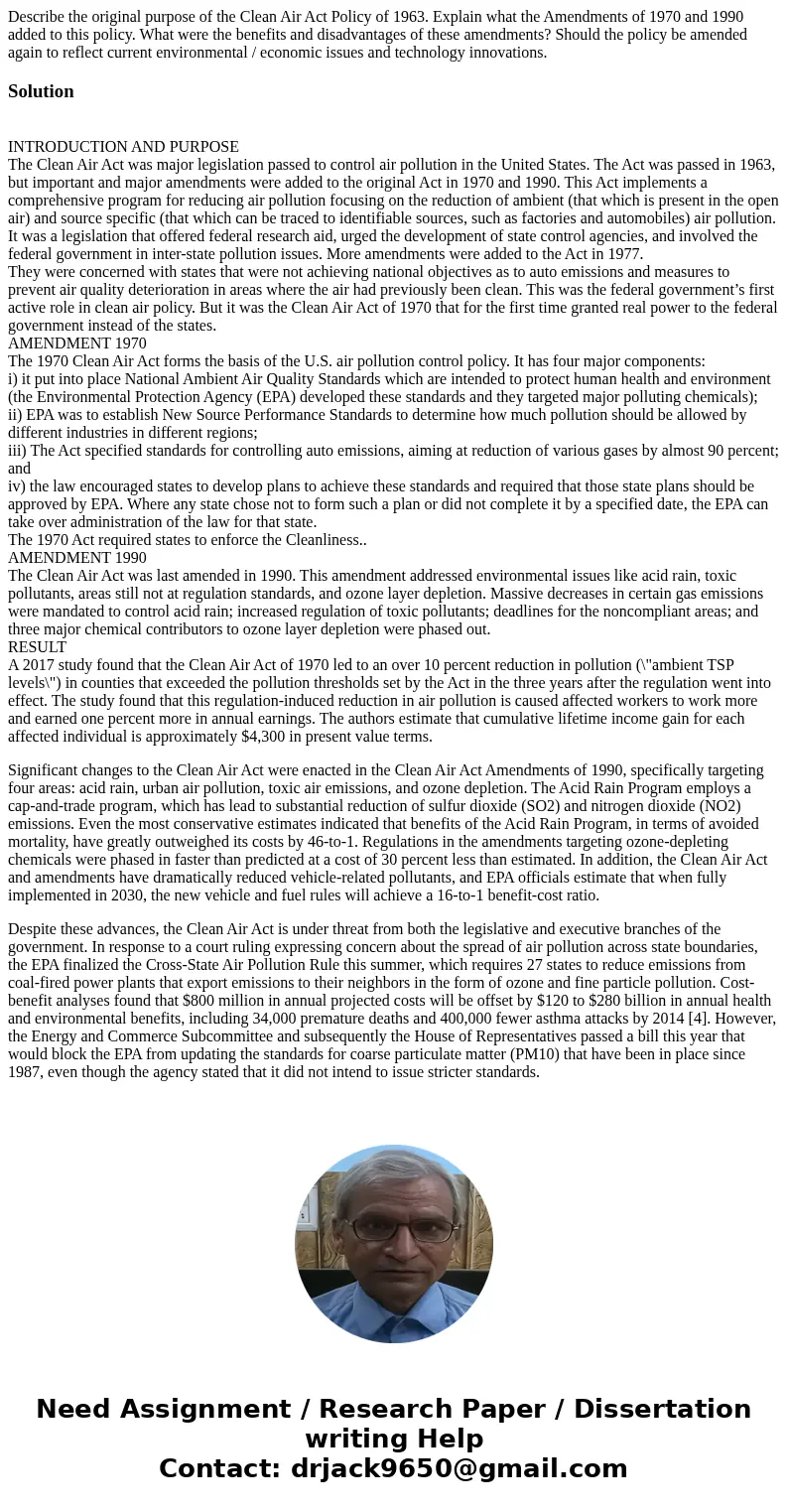Describe the original purpose of the Clean Air Act Policy of
Describe the original purpose of the Clean Air Act Policy of 1963. Explain what the Amendments of 1970 and 1990 added to this policy. What were the benefits and disadvantages of these amendments? Should the policy be amended again to reflect current environmental / economic issues and technology innovations.
Solution
INTRODUCTION AND PURPOSE
The Clean Air Act was major legislation passed to control air pollution in the United States. The Act was passed in 1963, but important and major amendments were added to the original Act in 1970 and 1990. This Act implements a comprehensive program for reducing air pollution focusing on the reduction of ambient (that which is present in the open air) and source specific (that which can be traced to identifiable sources, such as factories and automobiles) air pollution. It was a legislation that offered federal research aid, urged the development of state control agencies, and involved the federal government in inter-state pollution issues. More amendments were added to the Act in 1977.
They were concerned with states that were not achieving national objectives as to auto emissions and measures to prevent air quality deterioration in areas where the air had previously been clean. This was the federal government’s first active role in clean air policy. But it was the Clean Air Act of 1970 that for the first time granted real power to the federal government instead of the states.
AMENDMENT 1970
The 1970 Clean Air Act forms the basis of the U.S. air pollution control policy. It has four major components:
i) it put into place National Ambient Air Quality Standards which are intended to protect human health and environment (the Environmental Protection Agency (EPA) developed these standards and they targeted major polluting chemicals);
ii) EPA was to establish New Source Performance Standards to determine how much pollution should be allowed by different industries in different regions;
iii) The Act specified standards for controlling auto emissions, aiming at reduction of various gases by almost 90 percent; and
iv) the law encouraged states to develop plans to achieve these standards and required that those state plans should be approved by EPA. Where any state chose not to form such a plan or did not complete it by a specified date, the EPA can take over administration of the law for that state.
The 1970 Act required states to enforce the Cleanliness..
AMENDMENT 1990
The Clean Air Act was last amended in 1990. This amendment addressed environmental issues like acid rain, toxic pollutants, areas still not at regulation standards, and ozone layer depletion. Massive decreases in certain gas emissions were mandated to control acid rain; increased regulation of toxic pollutants; deadlines for the noncompliant areas; and three major chemical contributors to ozone layer depletion were phased out.
RESULT
A 2017 study found that the Clean Air Act of 1970 led to an over 10 percent reduction in pollution (\"ambient TSP levels\") in counties that exceeded the pollution thresholds set by the Act in the three years after the regulation went into effect. The study found that this regulation-induced reduction in air pollution is caused affected workers to work more and earned one percent more in annual earnings. The authors estimate that cumulative lifetime income gain for each affected individual is approximately $4,300 in present value terms.
Significant changes to the Clean Air Act were enacted in the Clean Air Act Amendments of 1990, specifically targeting four areas: acid rain, urban air pollution, toxic air emissions, and ozone depletion. The Acid Rain Program employs a cap-and-trade program, which has lead to substantial reduction of sulfur dioxide (SO2) and nitrogen dioxide (NO2) emissions. Even the most conservative estimates indicated that benefits of the Acid Rain Program, in terms of avoided mortality, have greatly outweighed its costs by 46-to-1. Regulations in the amendments targeting ozone-depleting chemicals were phased in faster than predicted at a cost of 30 percent less than estimated. In addition, the Clean Air Act and amendments have dramatically reduced vehicle-related pollutants, and EPA officials estimate that when fully implemented in 2030, the new vehicle and fuel rules will achieve a 16-to-1 benefit-cost ratio.
Despite these advances, the Clean Air Act is under threat from both the legislative and executive branches of the government. In response to a court ruling expressing concern about the spread of air pollution across state boundaries, the EPA finalized the Cross-State Air Pollution Rule this summer, which requires 27 states to reduce emissions from coal-fired power plants that export emissions to their neighbors in the form of ozone and fine particle pollution. Cost-benefit analyses found that $800 million in annual projected costs will be offset by $120 to $280 billion in annual health and environmental benefits, including 34,000 premature deaths and 400,000 fewer asthma attacks by 2014 [4]. However, the Energy and Commerce Subcommittee and subsequently the House of Representatives passed a bill this year that would block the EPA from updating the standards for coarse particulate matter (PM10) that have been in place since 1987, even though the agency stated that it did not intend to issue stricter standards.

 Homework Sourse
Homework Sourse